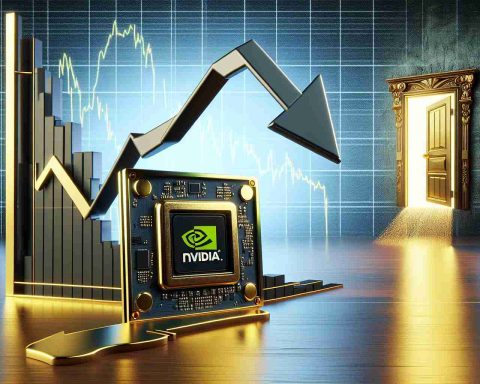- Nvidia holds an 80% market share in the AI chip industry, consistently chosen for high performance.
- Despite rising prices, companies invest in Nvidia, viewing it as a long-term cost-saving strategy.
- DeepSeek’s claims of low-cost AI model training sparked market concerns, leading to a significant drop in Nvidia’s stock.
- Experts doubt DeepSeek’s cost efficiency, suggesting the actual expenditure may be much higher than reported.
- Nvidia’s response involves promoting its innovations, such as the DeepSeek R1 as an Nvidia NIM microservice.
- Demand for high-powered GPUs remains strong, reinforcing Nvidia’s position in the AI ecosystem.
- Nvidia’s market presence is bolstered by continued interests from major tech companies like Meta and Tesla.
Nvidia, the powerhouse behind AI chips, commands an impressive 80% of the market, making it the go-to choice for tech giants seeking top-tier performance. Even with prices soaring for their cutting-edge GPUs, companies are willing to invest heavily, convinced that Nvidia’s technology saves them money in the long run.
However, recent buzz around Chinese startup DeepSeek has sent jitters through the market. DeepSeek boasted that it trained its R1 model in just two months for under $6 million — a fraction of what U.S. firms spend on Nvidia’s offerings. This revelation caused Nvidia’s stock to plunge nearly 17%, wiping out $600 billion in market value!
Yet, before you hit the panic button, let’s break this down. Experts are skeptical of DeepSeek’s cost claims, suggesting the actual expenses could top $500 million. Moreover, the R1 model relies on weaker Nvidia chips designed for China, raising questions about its true capabilities.
In response, Nvidia unveiled the DeepSeek R1 as an Nvidia NIM microservice, which allows developers to harness AI models and optimize their applications. This move highlights Nvidia’s commitment to innovation and strong performance, ensuring that its GPUs still reign supreme for serious AI tasks.
Nvidia reassured investors that the demand for high-powered GPUs remains strong. As tech titans like Meta and Tesla continue to seek excellence, Nvidia’s stock could very well soar again. It seems the fear surrounding DeepSeek is less a threat and more a reminder of Nvidia’s enduring dominance in the AI landscape.
Is Nvidia’s Market Dominance Threatened by Newcomers Like DeepSeek?
Nvidia currently commands an impressive 80% market share in the AI chip sector, making it the industry leader that tech giants rely on for high-performance graphics processing units (GPUs). Despite escalating prices for their advanced GPUs, companies are willing to invest significantly, believing Nvidia’s technology ultimately saves them money through efficiency and performance.
However, the recent emergence of the Chinese startup DeepSeek has raised concerns. DeepSeek claims it trained its R1 model in only two months for less than $6 million, a stark contrast to the substantial investments U.S. firms make in Nvidia technologies. This claim led to a nearly 17% drop in Nvidia’s stock, erasing a staggering $600 billion in market value.
Nevertheless, experts are skeptical about these cost-saving claims from DeepSeek. Some analysts estimate that the actual expenses for developing comparable AI technology could exceed $500 million. Additionally, the R1 model utilizes less powerful Nvidia chips designed for the Chinese market, casting doubt on its capabilities.
In response to this competitive pressure, Nvidia has launched the DeepSeek R1 as part of its NIM microservice suite, enabling developers to leverage powerful AI models to improve their applications. This strategic move illustrates Nvidia’s commitment to continuous innovation and solidifies its standing as the preferred choice for demanding AI tasks.
Nvidia also reassured clients and investors about the sustained demand for high-powered GPUs. As industry leaders like Meta and Tesla persist in pursuing cutting-edge technology, Nvidia’s stock is likely to rebound. Overall, the concerns surrounding DeepSeek may highlight its innovation potential, but they simultaneously reinforce Nvidia’s long-established dominance in the AI sector.
Key Insights and Features:
– Market Position: Nvidia holds an 80% share of the AI chip market, a testament to its industry dominance and leadership.
– Emerging Competitor: DeepSeek’s aggressive pricing and rapid development raises questions about traditional models and spending in the AI chip market.
– Nvidia’s Innovation: By launching the DeepSeek R1 as part of its services, Nvidia demonstrates ongoing innovation to maintain its competitive edge.
Important Questions Answered:
1. What are the implications of DeepSeek’s claims for Nvidia?
DeepSeek’s cost-efficient model poses a potential threat to Nvidia as it highlights the possibility of producing AI models at a fraction of the cost. However, skepticism about the R1’s capabilities and reliability tempers this threat.
2. How does Nvidia plan to counteract competition from emerging AI startups?
Nvidia continues to invest heavily in R&D and innovate its product offerings, as seen with the introduction of the DeepSeek R1 microservice. This strategy aims to maintain its market lead over competitors.
3. Will Nvidia’s stock recover from recent declines?
Analysts remain optimistic about Nvidia’s long-term prospects, especially with ongoing demand for high-performance GPUs from major tech companies, suggesting that Nvidia’s stock may stabilize and potentially increase in value in the near future.
For more information about Nvidia and its market strategies, visit Nvidia.




















